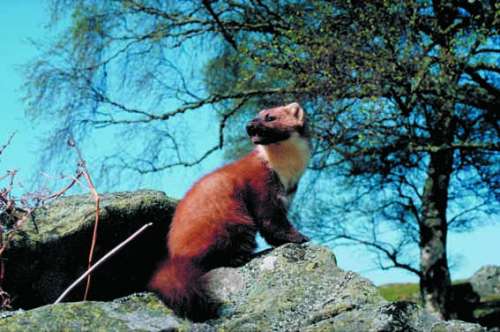 Image © Wild Lomond.
Image © Wild Lomond.
AuthorWilliam Paterson |
Date2006-2007 |
Project TypeUndergraduate dissertation |
SubjectZoology |
DatasetsOrdnance Survey data Sources: Digimap, UK Data Service Census Support (formerly UKBORDERS), Landmap, UK Data Archive Dates/Editions: All available. Scales: All available. |
Related SubjectsEcology; GIS |
Key WordsPine martens; ecology |
|
Publishing Institution |
|
SummaryAbstract from the publication (linked below): "In this study into the diet of pine martens, scats were collected from four sites in the Loch Lomond and The Trossachs National Park, Scotland. Analysis of prey remains in scat samples showed that there was no evidence of squirrel predation at any of the chosen study sites. This was despite population estimates using cone feeding transects indicating that squirrels were present within pine marten ranges in at least two different sites. Hair tube surveys were also carried out which confirmed the presence of red squirrels in Glenbranter. Field voles were found in a higher proportion of scats in Glenbranter and Auchineden than at Sallochy and Duke’s Pass which may be explained by seasonal variation in numbers. Field voles were the most frequent prey identified while plant material that included seasonally abundant rowan berries was found in a higher proportion of scats at two sites. These findings are in line with other studies of pine marten diet in Scotland that show the field vole to be the preferred prey species of pine martens occurring in a higher proportion of scats from the winter onwards and that fruits and berries occur in a higher proportion of scats in summer and autumn. This study suggests that pine martens are not preying upon squirrels in the National Park, possibly because squirrels were found to be absent or occurred at very low densities in the chosen study sites." |
|
MethodologyThe diet of pine martens was determined by collecting scat (faeces) samples in the field. The GPS points of the location of scats were recorded and the data analysed in the final study. Generated maps allowed for a visual representation of the location and altitude at which pine martens were concentrating their activity. |
|
Results/OutcomePaterson, W. D. and Skipper, G. 2008. The diet of pine martens (Martes martes) with reference to squirrel predation in Loch Lomond and The Trossachs National Park, Scotland. The Glasgow Naturalist, 25(1), 75-82. A PDF of this research publication can be downloaded here. |
|
References & AcknowledgementsFrom the publication (linked above): "This project was undertaken as a final year dissertation by WP for a BSc in Zoology at the University of Glasgow. We would like to thank Dr. Dominic McCafferty for his support and advice throughout this project. We are grateful to Pat Mclaughlin, Irene Leighton and Graham Adam for their help in providing lab space and equipment. We are grateful to Prof. Graeme Ruxton for his advice on statistics and also Prof. David Houston and Maggie Reilly for providing reference hairs. We would like to express our gratitude to staff in the National Park, Marion McCahon and Arthur Hannan, for their local knowledge of Glenbranter and Sallochy. We thank Mr. David Anderson of the Forestry Commission for providing expert knowledge on the study areas in this project. His advice made this project possible. Finally, I (WP) would like to thank members of my family (Angela, Dylan and John) for providing their company in the field while carrying out the collection of scats and squirrel surveying." |
|
|
|
|